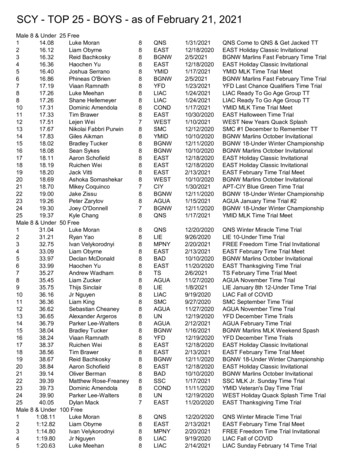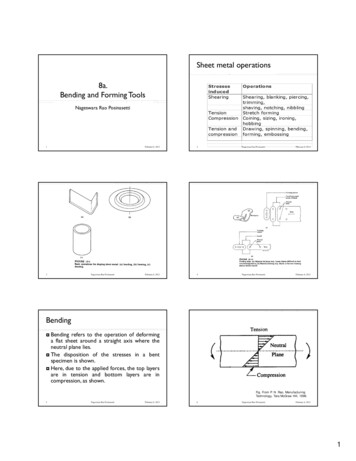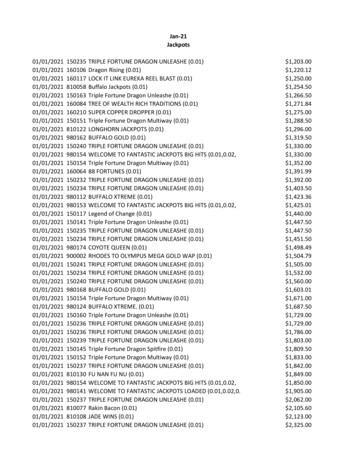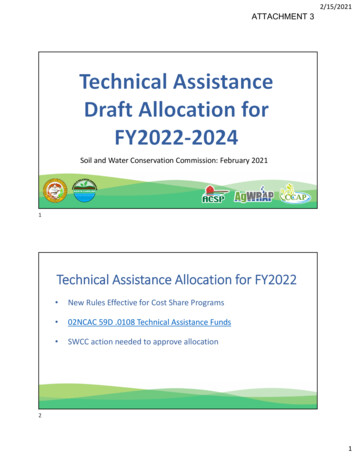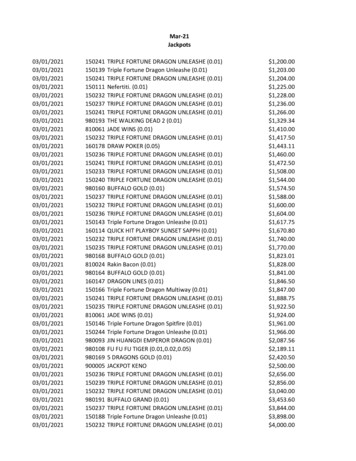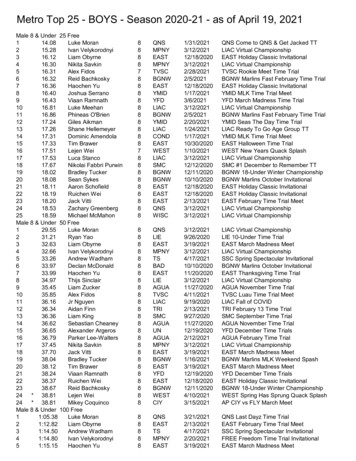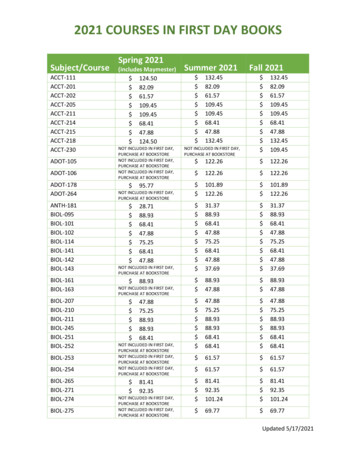
Transcription
FamilyandConsumerSciencesFebruary2021Jessamine County95 Park DriveNicholasville, KY 40356(859) 885-4811Jessamine.ca.uky.eduNewsletterAgent NoteHelloI hope you have had a great start to the year so far! Pleasetake a close look at upcoming programs in this newsletter.Cooking Through the Calendar (formerly called Lunch N'Learn) has started back via Zoom. The hope is for theprogram to transition to in-person later in the year. If youcannot join the program LIVE, you can watch the recordingof the recipe demonstration on the Jessamine CountyCooking Through the Calendar Facebook group.Programs at the Jessamine County Extension Office will stillbe online in February. We encourage clubs to hold offmeeting in-person in February, but if your club needs tomeet, please give me a call.I challenge Extension Homemakers to call at least one clubmember or send one member a card in the mail during themonth of February. You never know what a simple card orphone call can do to brighten someone's day.Sincerely,Karli GilesFCS AgentFollowusOnline!**We post all classes on our Facebook page andwebsite! Following us online is an easy way to stay "inthe know" with Jessamine County FCS Extension.The Cooperative Extension Service prohibitsdiscrimination in its programs andemployment on the basis of race, color, age,sex, religion, disability, or national origin. Tofile a complaint of discrimination, contactTim West, UK College of Agriculture, 859257-3879; Terry Allen or Patty Bender, UKOffice of Institutional Equity and EqualOpportunity, 859-257-8927; or the USDA,Director Office of Civil Rights, Room 326-WWhitten Bldg., 14th & Independence Ave. SW,Washington, DC 20250-9410 (202-720-5964).Inclement WeatherWinter is here, and with that comes thepossibility of snow! Inclement weathermay lead to in-person Extension programsbeing canceled or moved to an onlineformat. To stay in the know with officeclosings and changes in program formats,follow the Jessamine County Family andConsumer Sciences Extension page.Jessamine County Family and Consumer Sciences onFacebook: sity of Kentucky Family and Consumer SciencesExtension Podcast: https://ukfcsext.podbean.com/Check out our county website for information on allprogram areas: http://jessamine.ca.uky.edu/
Homemaker CornerSensational SaladsFebruary 23rd @ 1 p.m.taught via ZoomSalads have been a mainstay in menuplanning for years as they add color, texture,and freshness to a meal. They are always agreat way to add vegetables and othernutritious foods into the diet. Please join usfor a lesson about building salads that arenutritious and balanced!Craft Camp UpdateThe Fort Harrod Area Craft Campscheduled for June 18-19th at the BoyleCounty Extension Office has beenpostponed. The craft camp committee willmeet again this summer and look at datesto reschedule Craft Camp later in the year.To sign-up call the office at 859-885-4811 or emailkarli.giles@uky.eduJessamine CountyHomemaker ClubsFace MasksHearts N' HandsFirst Tuesday of the month, 10 a.m. at theExtension OfficeTown N' CountryThank you to everyone who made face masks todonate to Nicholasville Elementary. Wedonated a total of 100 face masks!First Tuesday of the month, 6 p.m. at theExtension OfficeHappySecond Tuesday of the month, 6:30 p.m. in amember's homeDog Beds4-H MothersThird Wednesday of the month, 9:30 a.m. in amember's homeEdgewood EveningThird Monday of the month, 6:30 p.m. at theExtension OfficeExtension Homemakers are still at work tomake dog beds to the Jessamine County AnimalShelter. To date, we have donated 56 beds to theanimal shelter. Thank you to those who arevolunteering their time and fabric scraps tothese efforts!
2021 Food & NutritionCalendars are here!Big Blue Book ClubStop by the office to pick oneup today!Join us for 'Flipping A Switch: Your Guide toHappiness and Financial Security in Later Life' byDr. Barbara O'Neill. Book club sessions will be onThursdays: February 25, March 4, and March 11 andwill be taught online.To sign-up for the Book Club, call the office at 859885-4811 or email karli.giles@uky.edu. You will needan email address to sign-up.If you would like a copy of the book, email Karli atkarli.giles@uky.edu BY January 27th.
Storing Fresh Fruits and Vegetables for Best FlavorStore in the refrigeratorFRUITApp les(more than 7 days)ApricotsAsian pearsVEGETABLESBerriesCherriesCut FruitFigsGrapesArtichokesAsparagusGreen BeansBeetsBelgian EndiveBroccoliBrussel SproutsCabbageCarrots1. Place fru its and vegetables in separate, perforated plastic bags.2. Use within 1-3 days for maximum flavor and freshness.CauliflowerCeleryCut VegetablesGreen OnionsHerbs (not bas iI)Leafy SproutsSummer SquashesSweet Corn3. Store each group in different produce drawers in therefrigerator to mi nimize the detrimental effects of ethyleneproduced by the fruits on the vegetables.Ripen on the counter first, then refrigerateAvocadosKiwiNectarinesPeachesPears1. To prevent moisture loss, store fruits and vegetables separatelyin a paper bag, perforated plastic bag, or ripening bowl on thecounter away from sunlight. Ripening fruit in a bowl or paperbag can be enhanced by placing an apple with the fruit to be ripened.PlumsPlumcots2. After ripening, store in refrigerator and use within 1-3 days.Store only at room temperatureFRUITApples(fewer than 7 days)BananasCitrus ainPomegranatesVEGETABLESBasil (in water)CucumbertEggplant t1. Many fruits and vegetables should only be stored at room temperatures.Refrigeration can cause cold damage or prevent them from ripening to goodflavor and texture. For example, pink tomatoes ripen to a better taste andred color if they are left at room temperature. In the refrigerator, they donot turn red, and even red tomatoes kept in the refrigerator lose their flavor.Gar nter SquashesPumpkinsSweet Potatoes*2. Keep away from direct sunlight.*Store garlic, onions, potatoes, and sweet potatoes in a well-ventilatedarea in the pa ntry.tCucumbers, eggplant, and peppers can be refrigerated for 1-3 daysif they are used soon after removing from the refrigerator.Cleaning Your ProduceAlways keep produce separate from raw meat, poultry, and seafood. Never use detergent or bleach to wash produce.Instead, rinse produce under running tap water immediately prior to use, including those with skins and rinds that are notieaten. Washing too far in advance removes some of nature's natural preservat ves. However, head lettuce or leafy greensremain cri sper when washed right away and then refrigerated. Packaged fruits and vegetables labeled "ready-to-eat,""washed," or "triple washed" need not be washed. Refrigerate all cut, peeled, or cooked fruits and vegetables within 2 hours.For information on how to store other fruits and vegetables go to FruitsAndVeggiesMoreMatters.orgSource: UC Davis Postharvest Technology 2012 Produce for Better Health Foundation.
University of KentuckyCollege of Agriculture,Food and Environment" CooperativeExtension ServiceFCS5-464Downsizing Your HomeA Guide for Older AdultsJennifer L. Hunter and Kristyn Jackson, Family and Consumer SciencesDownsizing to a smaller home has become a recenttrend. Older adults in particular can benefit fromsuch a move. Smaller homes typically require lessmaintenance and can result in significant savings forthe homeowner because of lower utility bills, propertytaxes, and insurance.The downsizing process is appealing to many, but itcan also be intimidating. Downsizing involves sorting,donating, and disposing of household possessions thathave accumulated over the years.Starting the Downsizing ProcessFirst, assess your needs and wants for a new home.Identifying your housing goals will help you to find a newhome that best fits your needs. Several housing optionsare specifically designed to meet the needs and wants ofolder adults. What type of space will work best for you?Housing Options Age-restricted communities. These communitiesare also referred to as "active adult" communities andare designed for older adults who prefer to live aroundother individuals their own age. Typically, residentsare over the age of 55. You will find single-familyhomes, townhomes, and apartments connected bysidewalks that allow for independence as well as astrong sense of community. Age-restricted commu nities focus on an active lifestyle for their residentsand may offer clubhouses, tennis courts, and golfcourses. Senior apartments. Age-restricted apartmentsare sometimes more affordable than age-restrictedcommunities and are based upon the same idea.Apartments are available to residents over the ageof 55. Living in age-restricted apartments offersthe advantages of accessibility, transportation, rec reational activities, and social services. In addition,maintenance is usually included in the cost. Continuing-care retirement community. Thistype of community is a hybrid community. Con tinuing-care communities offer independent-livingapartments and homes similar to those found inretirement communities. However, they also offerassisted living and nursing-level care, which is re flected by higher upfront costs. Residents typicallyenter at the independent-living level and then moveto assisted living or nursing-level care as they needmore assistance and care.Cooperative Extension Service I Agriculture and Natural Resources I Family and Consumer Sciences I 4-H Youth Development I Community and Economic Development
Assisted living facility. An assisted living facility al lows older adults to stay independent for the longesttime. Facility staff assist residents with personal caresuch as bathing, dressing, and medication manage ment. Most of these facilities consist of apartment style living and offer meals, activities, housekeeping,and transportation. Long-term care/skilled nursing facilities. Long term care facilities provide skilled nursing care forresidents who suffer from acute or terminal medicalconditions. These facilities employ doctors, nurses,and nursing assistants to care for the residents.Preparing Your Former Home andPossessionsAfter you identify which housing option is best for you,estimate the amount of space that you will have availablein your new home. Knowing the amount of space thatyou will have will help you make decisions about whichitems to keep, and which to sell, donate, gift, or discard. Downsizing involves sorting through your personalitems to determine which will be moving with youand which you may need to let go. Recognize thatit will take a considerable amount of time-some times months-to sort through your personal items.Downsizing is a great opportunity to declutter andprepare for your new lifestyle. Downsizing can be overwhelming. Do nottryto tacklethe entire house in one weekend. The easiest approachis to start with the room that you use least often. Develop a sorting system that works for you andgather the necessary supplies (paper and pencil, boxes,packing supplies). For smaller items, consider havingboxes labeled sell, donate, gift, discard, and keep. Youcan use those boxes to sort through items as you gothrough each room.Weighing Your OptionsUse the checklist below to determine which option isbest for you. Choose the features that are desirable to you.Label the options with the locations you have scouted.Under each option, place a checkmark to indicate whichfeatures are available.Remember, a smaller home or apartment that is notpart of a retirement community is also an acceptab!ehousing option. The most important aspect of downsiz ing is to pick the option that is right for you.Location 1Location 2Location 3Desirable Housing ConsiderationI will be able to take care of the house and yard,or maintenance is not required.I will be able to pay the taxes, insurance, and utilities.I will be able to pay any fees associated with living in thecommunity or neighborhood.I will be close to family and friends.Community services and recreational facilities are available.Home care and meals are available.The house includes features to aid accessibility (absence ofsteps, wider doorways and hallways, space for wheelchairs,bathrooms equipped with safety features, and kitchenswith pull-out shelves, etc.)Nursing level care will be available.Remember, a smaller home or apartment that is not part of aretirement community is also an acceptable housing option.2
For smaller items, considerhaving boxes labeled sell,donate, gift, discard, and keep.You can use those boxes tosort through items as you gothrough each room.Moving TaskNecessary CompletedGet estimates from at least threemoving companies.Select a moving company and set afirm move date.Make a floor plan of your new hometo decide where you will place largefurniture.Check to make sure that all boxesare labeled to indicate in whichroom they should be placed in yournew home. If you are thinking about hosting a yard sale, priceitems as you go through each room It may be temptingto price items based on your personal attachment tothem, but be careful not to let this happen. Your goalis to rid yourself of these items so that you can makea profit and move into your new home without clutter.If you have large furniture, antiques, or high-dollaritems, consider working with an auction companyor resale shop to maximize your profits. Ask your adult children to remove their belongings.You may have discovered that your children have beenusing your home as a storage unit for childhood rel ics. Keep in mind that you will no longer have spacefor extra items and encourage your children to thinkcarefully about which items they wish to keep. Find a way to hold on to memories while letting go ofthe "stuff." You can honor the items that youhave heldonto by talking about them, taking photos, writingdown memories, or recording your family sharingstories about them. Only keep those items that youtreasure the most. Consider bequeathing items early. Identify the itemsthat you want certain family members to have andconsider which of those items you may be willingto bequeath now. You may enjoy giving these itemsto family members now so that you can see themenjoying what you have set aside for them. If you begin to feel overwhelmed, shut the door, take abreak, and come back to the room later. Think aboutinviting a close friend or family members over tohelp with the process. Revisiting household items isa great time to share and pass on memories.If you have pets, plan how they willbe moved to your new home.If needed, establish a relationshipwith a new healthcare provider.Refill and transfer prescriptions.Arrange for the utilities in your oldhome to be transferred out of yourname.Arrange for the utilities in your newhome to be transferred to you.Complete the following address changes:- Post office- Bank account- Credit cards- Investment/retirementaccounts- Medicare and Social Security- Driver's license and carregistration- Voter's registration- Newspaper and magazinesubscriptions- Family and friends- Lawyer, accountant, insuranceagent, etc.- Other:Preparing Your New Home- Other:Whether you are getting ready to move cross-town orcross-country, make sure that you are well preparedbefore moving day arrives. The following checklist willassist you in making sure that you have completed allof the necessary planning and paperwork.- Other:3
Downsizing Your Home A Guide for Older Adults Jennifer L. Hunter and Kristyn Jackson, Family and Consumer Sciences Downsizing to a smaller home has become a recent trend. Older adults in particular can benefit from such a move. Smaller homes typically require l

